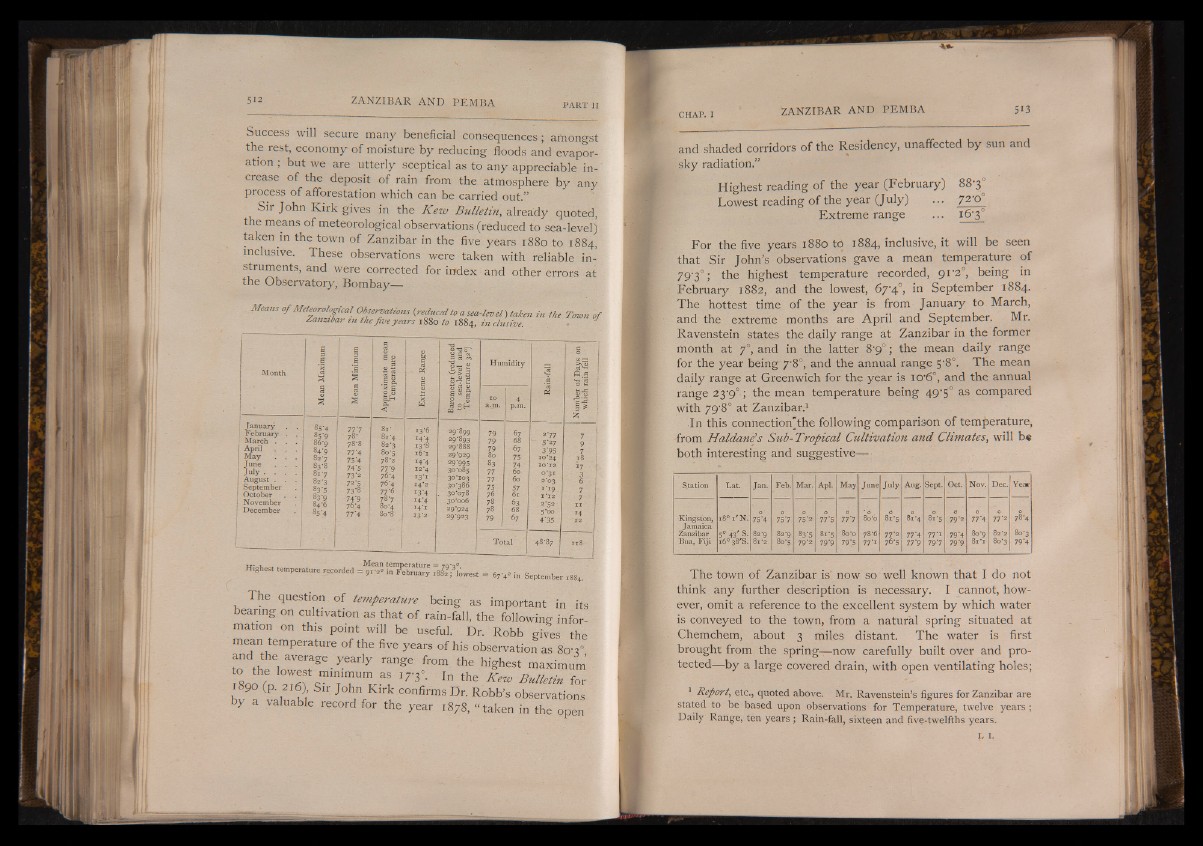
Success will secure many beneficial consequences; amongst
the rest, economy of moisture by reducing floods and evaporation
; but we are utterly sceptical as to any appreciable increase
of the deposit of rain from the atmosphere by any
process of afforestation which can be carried out.”
Sir John Kirk gives in the Kew Bulletin, already quoted,
the means of meteorological observations (reduced to sea-level)
taken in the town of Zanzibar in the five years 1880 to 1884,
inclusive. These observations were taken with reliable instruments,
and were corrected for index and other errors at
the Observatory, Bombay—
Means o f Meteorological Observations {reduced to a sea-lev e l ) taken in the Town o f
Zanzibar in the fiv e yea rs 1880 to 1884, in c lu siv e . .
Month
January
February
March
I April
May
June
July .
August
September
! October
November
December
s 5'4
8S'9
86*9 84-9
82 *7
83*8
81*7
82'3
83 *5
83 *9
84-6
85 ’4
7 7 ’7 78*
78-8
77'4
75*4
74’5
7 3 '2
72'5 73-8
74‘9 76.'4
77‘4
£ «
aH <a.
81'4
82*3
80 *s
78*2
77*9 7766**44
77 '6
78-7 80*4
fcll «& a«. EO w 7c?
Humidity
13*6
14-4
13-8
i 6 "i
14'4
12*4
*3’i 14-2'
I 3 ’4
14-4
14-1
29-899
29-893
29*888
29*929
29 ‘995
30*085
30*103
30*386
30*078
30*006
29*924
29*923
a.m. p.m.
79
79
79
80
83
77
77
75
76 78
78
79
67
68
67
75
74
60
60
57
61 63
68
67
2 *77
5 ‘2 7
3*95
10*24 10*12
0*31
2*03
1*19 1*12
2*52
S'oo
4*35
Ö.S uO* Uas
Total
7
97
18
*7
36
7
7
it- u Mean temperature = 70*2°
Highest temperature recorded = ¡ g | in February S l o w e s t 1 67-4» in September ,884.
The question of temperature being as important in its
bearing on cultivation as that of rain-fall, the following information
on this point will be useful. Dr. Robb gives the
mean temperature of the five years of his observation as 8cn°
and the average _ yearly range from the highest maximum
^ 35 I7'3°- In the Kew Bulletin for
1890 (p. 216) Sir John Kirk confirms Dr. Robb’s observations
by a valuable record for the year 1878, “ taken in the open
and shaded corridors of the Residency, unaffected by sun and
sky radiation.”
Highest reading of the year (February) 88-3°
Lowest reading of the year (July) . . . 720°
Extreme range ... i6‘3°
For the five years 1880 to 1884, inclusive, it will be seen
that Sir John’s observations gave a mean temperature of
79-3°; the highest temperature recorded, 91 '2°, being in
February 1882, and the lowest, 6p4°, in September 1884.
The hottest time of the year is from January to March,
and the extreme months are April and September. Mr.
Ravenstein states the daily range at Zanzibar in the former
month at 7°, and in the latter 8‘9°; the mean daily range
for the year being 7-8°, and the annual range 5 ‘8°. The mean
daily range at Greenwich for the year is iO‘6°, and the annual
range 23-9°; the mean temperature being 49'5° as compared
with 79‘8° at Zanzibar.1
In this connection’ the following comparison of temperature,
-from Haldane's Sub-Tropical Cultivation and Climates, will b#
both interesting and suggestive—
Station Lat. Jan. Feb. Mar. Api. May June July Aug. Sept. Oct. Nov. Dec. Year
Kingston, i8 °i'N . 75*4 0 75*7 75*2 0
77'5
0 77*7 80*0
g
8i "5
H 09 O
0
81 *5 0 79 *2
0 77*4 0 77*2 0
78-4
Jamaica
Zanzibar 5° 43' S. 82*9 82*9 83*5 8i *5 80‘0 78*6 77*2 77*4 77*i 79*4 80*9 82*2 80-3
Bua, Fiji 160 38 S. 81*2 80*5 79*2 79*9 79*5 77*i 76*5 7.7*9 79*7 79*9 81 *i 80*3 79*4
The town of Zanzibar is' now so well known that I do not
think any further description is necessary. I cannot, however,
omit a reference to the excellent system by which water
is conveyed to the town, from a natural spring situated at
Chemchem, about 3 miles distant. The water is first
brought from the spring— now carefully built over and protected—
by a large covered drain, with open ventilating holes;
1 Report, etc., quoted above. Mr. Ravenstein’s figures for Zanzibar are
stated to be based upon observations for Temperature, twelve years ;
Daily Range, ten years ; Rain-fall, sixteen and five-twelfths years.
I, L